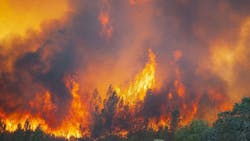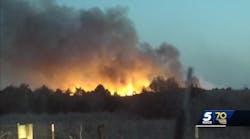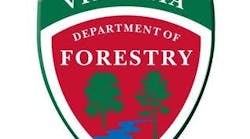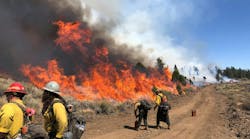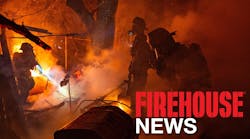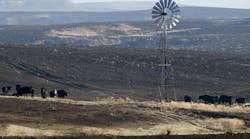Aug. 31 -- As California suffers through one of its worst fire seasons in recent history, state lawmakers are closing in on a final vote Friday night on a sweeping package to provide $1 billion over the next five years to reduce the risk of wildfires across the state.
The proposal, drawn up by state lawmakers this week, would fund grants to fire departments, cities, counties and non-profit organizations to thin brush, cut fuel breaks and reduce fire danger in hundreds of communities around the state in high-risk areas, from the Santa Cruz Mountains and Oakland Hills to the Sierra Nevada and Southern California.
If the plan is approved Friday evening, as many Sacramento observers are expecting, Cal Fire, the state’s primary firefighting agency, will distribute $200 million a year through 2024. The money will come from California’s greenhouse gas reduction fund, made up of money that oil refineries, large factories and other polluters pay to buy credits at state auctions permitting them to emit greenhouse gases.
The package also includes proposals by Gov. Jerry Brown to relax logging rules on private land statewide to make thinning forests easier.
Lawmakers did not embrace everything Brown was proposing last week. But the bill still would allow trees up to 30 inches in diameter to be cut without landowners obtaining a state timber harvest permit — up from 26 inches now, but not 36 inches as Brown had requested — when they are thinning forests to reduce fire risk. It also would allow logging roads up to 600 feet long to be built on private land without a permit, as long as they are replanted.
But the deal does not come without politics and some backroom dealing.The fire safety provisions were to have been included in a separate bill, but legislative leaders in Sacramento lumped them into one bill — SB 901 — that also includes controversial language to reduce the multi-billion-dollar liability of PG&E and other utilities when their power lines start costly wildfires.
Sources said Thursday the reason for putting all the different issues into one bill is to give lawmakers who may be worried about the political risk of being accused of “bailing out” PG&E an incentive to vote for it, given expected popularity of the broader historic fire safety package and funding.
The compromise cleared a key hurdle Tuesday night when it was approved 7-1 by a conference committee on wildfire issues. A final vote in the Assembly and Senate is expected between 8 p.m. and midnight Friday, the deadline for all bills to be passed or die for the year in the state Capitol.
The fire reduction measures are supported by the state’s timber industry and some environmental groups, although some oppose the relaxation of the logging rules.
“On balance, it’s the most significant commitment we’ve made to funding forest restoration, maybe ever,” said Paul Mason, vice president of the Pacific Forest Trust, an environmental group based in San Francisco.
“Making the sort of investment that we have here will make a difference over time,” he said. “But it is going to take a long time — decades — to restore our forests to the condition they were before logging and fire suppression changed them so much.”
The wildfire fund and logging reforms are a direct reaction to the fact that massive wildfires have devastated California this year and last year. So far in 2018, roughly 1.14 million acres have burned.
The largest fire in recorded state history, the Mendocino Complex Fire, is still burning in Lake, Mendocino and Colusa counties. That fire, which began July 27, was 93 percent contained on Thursday, having burned 459,102 acres, an area roughly the size of Los Angeles, San Jose and San Francisco combined. Other huge fires have burned more than 1,000 homes in Redding and temporarily closed Yosemite National Park this summer.
“We absolutely need significant, ongoing funding for prevention and vegetation management,” said Assemblyman Jim Wood, D-Santa Rosa, at a hearing Tuesday night.
If approved Friday night, the new wildfire fund would be split, with $165 million a year to reduce fire risk in forests, oak woodlands, chaparral areas and other parts of California, and $35 million a year to fund prescribed burning projects.
Both types of projects are designed to reduce the amount of flammable material in forests, many of which burned regularly before the Gold Rush, thinning out brush and dead wood. After more than 100 years of fire fighting, however, many have grown unnaturally thick, generating enormous fires when blazes do start. Climate change also is causing temperatures to rise, drying out vegetation. And California’s growing population is putting more homes in areas that historically have burned as part of the state’s Mediterranean climate.
There are still some opponents. The Sierra Club California opposes the package, saying that it allows too much logging without enough oversight.
Kathryn Phillips, the club’s executive director, said Thursday the state should be tightening building codes, better enforcing rules requiring homeowners in fire-prone areas to clear space around their homes, and not allowing as much development in fire risk areas.
“This exempts plots of lands up to 300 acres from any kind of oversight,” she said. “You will end up not having anybody make sure that there won’t be substantial erosion and mudslides, which ruin wildlife habitat.”
Others cheered the changes, however, as important to reduce red tape.
“Those reforms are needed,” said Gary Sanchez, a State Farm insurance agent who also works as president of the Santa Clara County Fire Safe Council, a nonprofit group that helps residents clear vegetation and create fire escape routes around their homes. “What we’re facing now is unprecedented. We are losing life and property. There needs to be a lot more done to manage vegetation as temperatures are warming. We have to work more aggressively because we are facing a more aggressive fire season each year.”
___ (c)2018 the San Jose Mercury News (San Jose, Calif.) Visit the San Jose Mercury News (San Jose, Calif.) at www.mercurynews.com Distributed by Tribune Content Agency, LLC.
